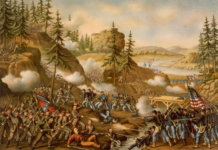The Civil War is said to be the first true modern war. This conflict brought forth the use of the first air force (hot air balloons) and machine guns (the rarely used gatling gun). The War was also the first to be reported and presented with photography. In addition, it was the first total war, meaning war was not only inflicted on soldiers, but civilians, land and cities as well. More important than, perhaps, any of the above characteristics is the role that women played in this terrible four year conflict.
Unlike any war prior, women played an enormous part in the lives of soldiers’, family and home life, and they had a significant hand in how the War progressed and eventually ended. With the men running off left and right to sign up for the cause, women were left behind to carry out the man’s duties at home. As the War progressed, many women of the South had to take on the work of the slaves who had either been freed, or run away. Both the departure of the men and the slaves transformed the women’s lives to more than existences of domesticity.
Women saw the War as an opportunity to be leaders in the fight for abolition and equality. Elizabeth Cady Stanton and Susan B. Anthony were organizers of the National Women’s Loyalty League which called for a constitutional amendment to end slavery. They fought for the woman’s right to vote, argued against differences in pay between men and women in manufacturing jobs, and fought for the absolute right to be nurses in the effort to ease the pain that this War was inflicting.
In addition to all this, women went as far as to be spies and soldiers for both sides. Knowing that women were not able by law to enlist as soldiers, some disguised themselves as men and served in both the Union and Confederate Armies. Many who did this were able to avoid getting caught, and served until either getting wounded or until the War’s end. Other women decided that being a spy was the best way to serve, and there were dozens of Southern, female spies in Washington DC, as well as one Northerner being in the Confederate White House.
Probably the most significant role of women was nursing. Thousands of women at the War’s outset left their homes to take care of dying soldiers. At first, many men were angered by this new role, and felt that it was unlady-like for women to care for naked and enlisted men. As the war raged on, however, and casualties were coming in at ever increasing numbers, demand for women nurses skyrocketed, and even those doctors who protested so loudly against women being in the operating rooms with them had to silence themselves. The United States Sanitary Commission, organized by the women of the North, ran kitchens, distributed medical supplies and inspected army camps to insure a standard of cleanliness. Over 3,000 Union women became unpaid nurses during the conflict, and Dorthea Dix, appointed head of the nursing corps, went unpaid for the entire four years at her post. Southern nurses were equally as vital to their cause setting up the largest, most efficient hospital on either side in Richmond, Virginia.
When talking about the Civil War, it is too often spoke of as a man’s war, fighting on the battlefields or serving on ship in the navy. Men ran the shows in both Washington and Richmond, recruited the soldiers, and organized the supply lines and military operations. It was the women, however, who were the lifelines of the Union and Confederacy. It was the women who tended the wounded tirelessly, ensured sanitary conditions and fought for causes that men were unable and possibly unwilling to fight for. The women’s role in the Civil War is just as significant as the man’s, and any discussion of the War in general should not leave this fact out.





